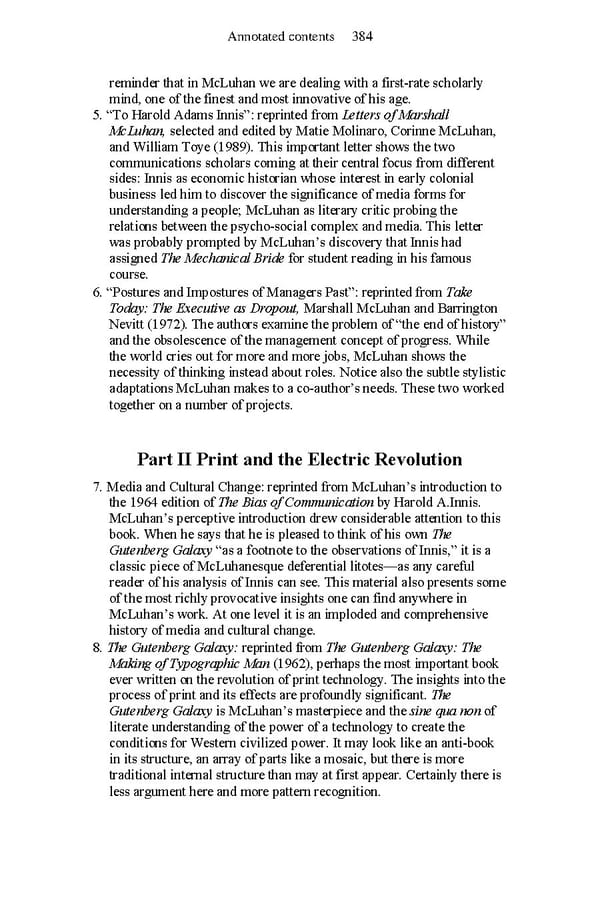Annotated contents 384 reminder that in McLuhan we are dealing with a first-rate scholarly mind, one of the finest and most innovative of his age. 5. “To Harold Adams Innis”: reprinted from Letters of Marshall McLuhan, selected and edited by Matie Molinaro, Corinne McLuhan, and William Toye (1989). This important letter shows the two communications scholars coming at their central focus from different sides: Innis as economic historian whose interest in early colonial business led him to discover the significance of media forms for understanding a people; McLuhan as literary critic probing the relations between the psycho-social complex and media. This letter was probably prompted by McLuhan’s discovery that Innis had assigned The Mechanical Bride for student reading in his famous course. 6. “Postures and Impostures of Managers Past”: reprinted from Take Today: The Executive as Dropout, Marshall McLuhan and Barrington Nevitt (1972). The authors examine the problem of “the end of history” and the obsolescence of the management concept of progress. While the world cries out for more and more jobs, McLuhan shows the necessity of thinking instead about roles. Notice also the subtle stylistic adaptations McLuhan makes to a co-author’s needs. These two worked together on a number of projects. Part II Print and the Electric Revolution 7. Media and Cultural Change: reprinted from McLuhan’s introduction to the 1964 edition of The Bias of Communication by Harold A.Innis. McLuhan’s perceptive introduction drew considerable attention to this book. When he says that he is pleased to think of his own The Gutenberg Galaxy “as a footnote to the observations of Innis,” it is a classic piece of McLuhanesque deferential litotes—as any careful reader of his analysis of Innis can see. This material also presents some of the most richly provocative insights one can find anywhere in McLuhan’s work. At one level it is an imploded and comprehensive history of media and cultural change. 8. The Gutenberg Galaxy: reprinted from The Gutenberg Galaxy: The Making of Typographic Man (1962), perhaps the most important book ever written on the revolution of print technology. The insights into the process of print and its effects are profoundly significant. The Gutenberg Galaxy is McLuhan’s masterpiece and the sine qua non of literate understanding of the power of a technology to create the conditions for Western civilized power. It may look like an anti-book in its structure, an array of parts like a mosaic, but there is more traditional internal structure than may at first appear. Certainly there is less argument here and more pattern recognition.
 Essential McLuhan Page 390 Page 392
Essential McLuhan Page 390 Page 392